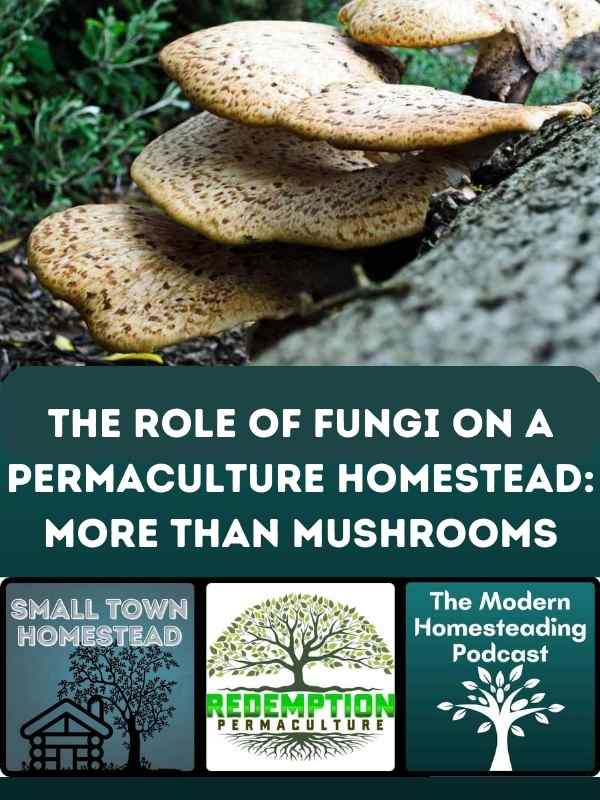In the realm of permaculture, where we seek to mimic nature’s most efficient and sustainable systems, fungi play a crucial role. While the common mushroom is the most recognized face of fungi, the hidden world of mycelium and other fungal forms is far more vast and influential than most realize. Let’s delve into the fascinating functions of fungi in permaculture.

The Vast Underground Network: Mycelium
Mycelium is often dubbed the “internet of the forest.” It forms a dense network of fine threads underground, connecting plants in a mutualistic relationship.
- Resource Distribution: Through mycelial networks, nutrients and water can be transferred between plants, ensuring a balanced ecosystem where resources are shared.
- Decomposition: Fungi are nature’s primary decomposers. They break down organic matter, turning dead plants and animals into nutrient-rich soil.
Fungi as Soil Builders
Healthy soil is the foundation of permaculture. Here’s how fungi contribute:
- Soil Structure: Mycelium forms a web-like structure that helps bind soil particles together. This improves water retention and reduces erosion.
- Organic Matter Digestion: Certain fungi species break down complex organic compounds in the soil, making them accessible to plants.
Natural Pesticides
Some fungi act as natural predators to pests. They can parasitize insects, offering a chemical-free method of pest control.
- Endophytic Fungi: Living within plants, these fungi can deter herbivores and protect plants from diseases.
- Entomopathogenic Fungi: These fungi infect and kill insects, acting as a biological control agent.
Culinary and Medicinal Uses
While mushrooms are the most familiar part of fungi, they’re a treasure trove of nutritional and medicinal value.
- Edibles: Many mushroom varieties, like shiitake or oyster, are delicious and nutritious. They’re packed with protein, fiber, vitamins, and minerals.
- Medicinal Mushrooms: Reishi, chaga, and cordyceps are just a few mushrooms known for their health benefits. They’ve been used for centuries in traditional medicine systems.

Mycorrhizal Relationships: A Plant’s Best Friend
Most plants form symbiotic relationships with fungi, known as mycorrhizal relationships.
- Nutrient Exchange: The fungus provides the plant with water and nutrients, and in return, the plant gives sugars to the fungus.
- Disease Resistance: These associations can also boost a plant’s immunity and increase its resistance to certain pathogens.
Fungi in Water Management
In permaculture, sustainable water management is key, and fungi can play a role in this as well.
- Mycelial Barriers: When integrated into garden beds or landscapes, mycelium can act as a natural filter, breaking down contaminants and pollutants.
- Rain Gardens: Incorporating fungi can help manage water flow, reduce runoff, and improve water quality.
Methods for Increasing Fungi Activity on a Permaculture Homestead
A thriving fungal population can significantly enhance the health and productivity of a permaculture homestead. But how does one go about promoting fungi activity in their garden or farm? Here are some effective methods to encourage these fantastic organisms.
1. Mulching with Organic Material
- Wood Chips: They decompose slowly and are a favorite for many fungi species. Over time, wood chips break down and become integrated into the soil, enriching it and promoting fungal growth.
- Straw or Hay: These can be layered over garden beds to provide a constant food source for decomposing fungi.
2. No-Till or Reduced-Till Farming
- Regular tilling disrupts the mycelial networks in the soil. By refraining from or minimizing tilling, you allow these networks to flourish and enhance soil health.
3. Inoculate with Mycorrhizal Fungi
- Purchase mycorrhizal fungi inoculants from reputable suppliers. By introducing them to your garden beds, plants can quickly establish beneficial symbiotic relationships.
- Mycorrhizal Fungi Inoculant for Plants – Myco Bliss contains 5 high performing…
- Super Concentrated Mycorrhizae – Myco Bliss is a powerful mycorrhizal inoculant…
- Retains Water & Nutrients – Using mycorrhizal fungi for plants helps them absorb…
Last update on 2025-07-10 / Affiliate links / Images from Amazon Product Advertising API
4. Create Fungi-Friendly Habitats
- Log Piles: Introducing logs or stumps in shaded areas of your garden can act as habitats for fungi. Over time, they’ll decompose and become home to various fungi species.
- Leave Plant Debris: Instead of clearing all plant waste, leave some in place. This organic matter becomes food for fungi.
5. Composting with Fungi in Mind
- Hugelkultur Beds: This method involves piling up logs, branches, and organic material and covering them with soil. As the wood decomposes, it promotes fungal activity.
- Layered Compost Piles: By layering organic materials, such as green waste, manure, and wood chips, you create an environment ripe for both bacterial and fungal decomposers.
6. Introduce Edible and Medicinal Mushroom Cultivation
- Stump Cultivation: Inoculate old stumps with mushroom spawn like shiitake or maitake.
- Straw Bale Cultivation: Certain mushrooms, like the oyster mushroom, can be grown on straw bales, further integrating fungi into your homestead.
7. Maintain Moisture Levels
- Fungi thrive in moist environments. Regular watering (without over-saturating the soil) and ensuring proper drainage can create an optimal environment for fungi.
8. Avoid Chemical Fertilizers and Pesticides
- These can harm or kill beneficial fungi in the soil. Opt for natural and organic methods of fertilization and pest control.
In Summary
The role of fungi in permaculture extends well beyond the delicious mushrooms we eat. From fostering plant health to building robust soils, fungi are an essential component in sustainable agriculture systems. Embracing their multifaceted contributions can lead to more resilient and thriving permacultural landscapes.
Promoting fungi activity in a permaculture homestead isn’t just about boosting soil health; it’s about recognizing the interconnectedness of all life forms and working in harmony with nature. By integrating fungi-friendly practices, you cultivate a more vibrant, resilient, and fruitful ecosystem.




